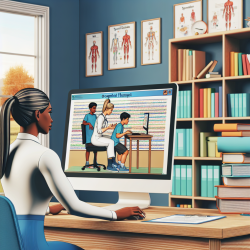Understanding 22q11.2 Duplication Syndrome and Its Impact on Autism Spectrum Disorder
As a speech-language pathologist, understanding the intricate connections between genetic syndromes and neurodevelopmental disorders is crucial. The recent study titled "22q11.2 Duplication Syndrome: Elevated Rate of Autism Spectrum Disorder and Need for Medical Screening" sheds light on the significant prevalence of Autism Spectrum Disorder (ASD) among individuals with 22q11.2 Duplication Syndrome (22q11.2DupS). This blog aims to help practitioners enhance their skills by implementing the research findings and encouraging further exploration.
Key Findings from the Study
The study conducted by Wenger et al. (2016) highlights several critical findings:
- Approximately 38% of children aged 2-18 with 22q11.2DupS had community diagnoses of ASD.
- Upon clinical evaluation using gold-standard measures, 14-25% met the criteria for ASD.
- The study emphasizes the necessity of comprehensive medical screening for individuals diagnosed with 22q11.2DupS.
These findings are significant, as they indicate one of the highest rates of ASD among genetic disorders, necessitating proactive medical and therapeutic interventions.
Implications for Practitioners
For practitioners, these findings underscore the importance of early identification and intervention. Here are some actionable steps to consider:
- Early Screening: Implement routine genetic testing and medical screening for children showing developmental delays or ASD symptoms. Early detection can lead to timely interventions, potentially mitigating the impact of the disorder.
- Collaborative Approach: Work closely with geneticists, pediatricians, and other specialists to ensure a comprehensive care plan for children with 22q11.2DupS. Multidisciplinary collaboration is key to addressing the complex needs of these children.
- Data-Driven Interventions: Utilize data from assessments and screenings to tailor individualized therapy plans. This approach ensures that interventions are targeted and effective.
Encouraging Further Research
The study opens avenues for further research, particularly in understanding the neuropsychiatric and adaptive functioning profiles of individuals with 22q11.2DupS. Practitioners are encouraged to contribute to research efforts by:
- Participating in longitudinal studies to track developmental trajectories and intervention outcomes.
- Exploring the genetic underpinnings of 22q11.2DupS to better understand its impact on neurodevelopmental disorders.
- Collaborating with research institutions to gather data that can inform clinical practices and improve patient outcomes.
Conclusion
The study by Wenger et al. (2016) provides valuable insights into the relationship between 22q11.2DupS and ASD. By implementing the research findings and engaging in further research, practitioners can enhance their skills and contribute to improved outcomes for children with this syndrome. To read the original research paper, please follow this link: 22q11.2 duplication syndrome: elevated rate of autism spectrum disorder and need for medical screening.










